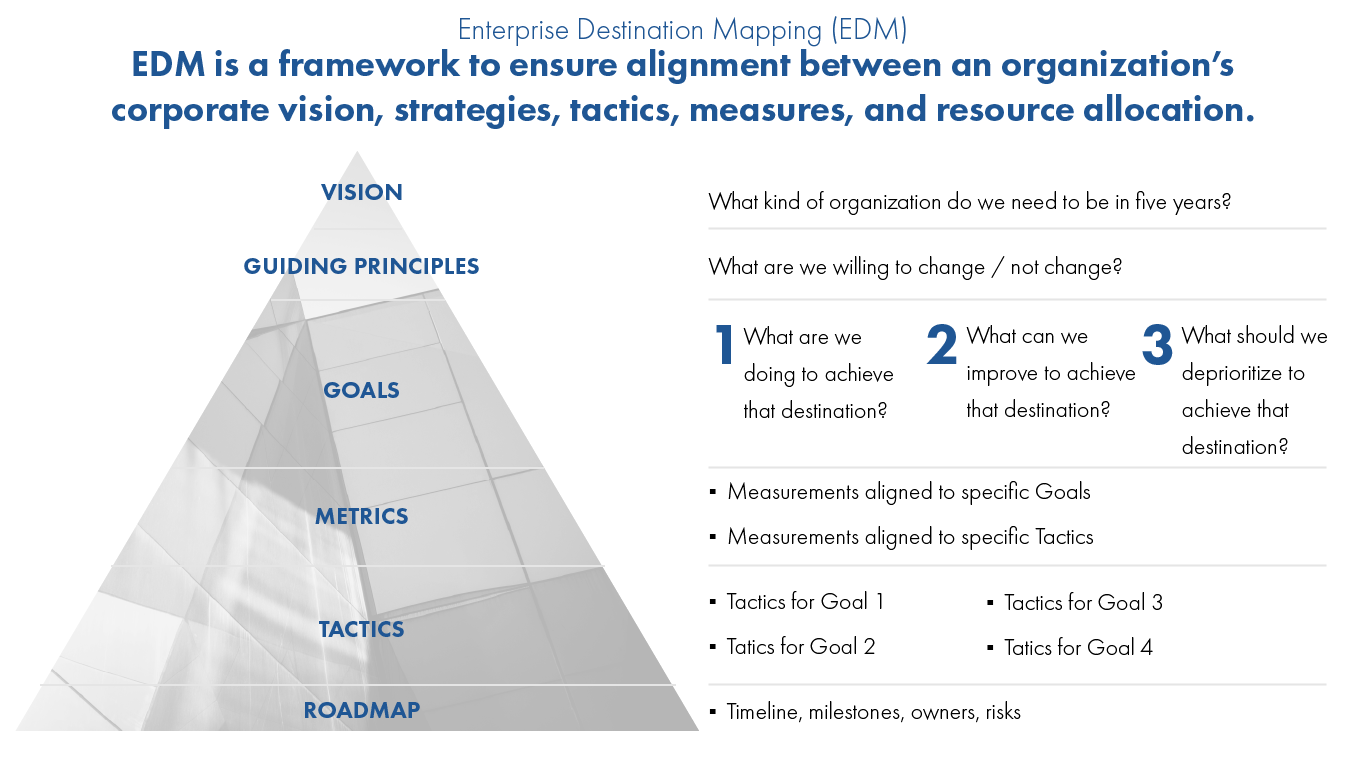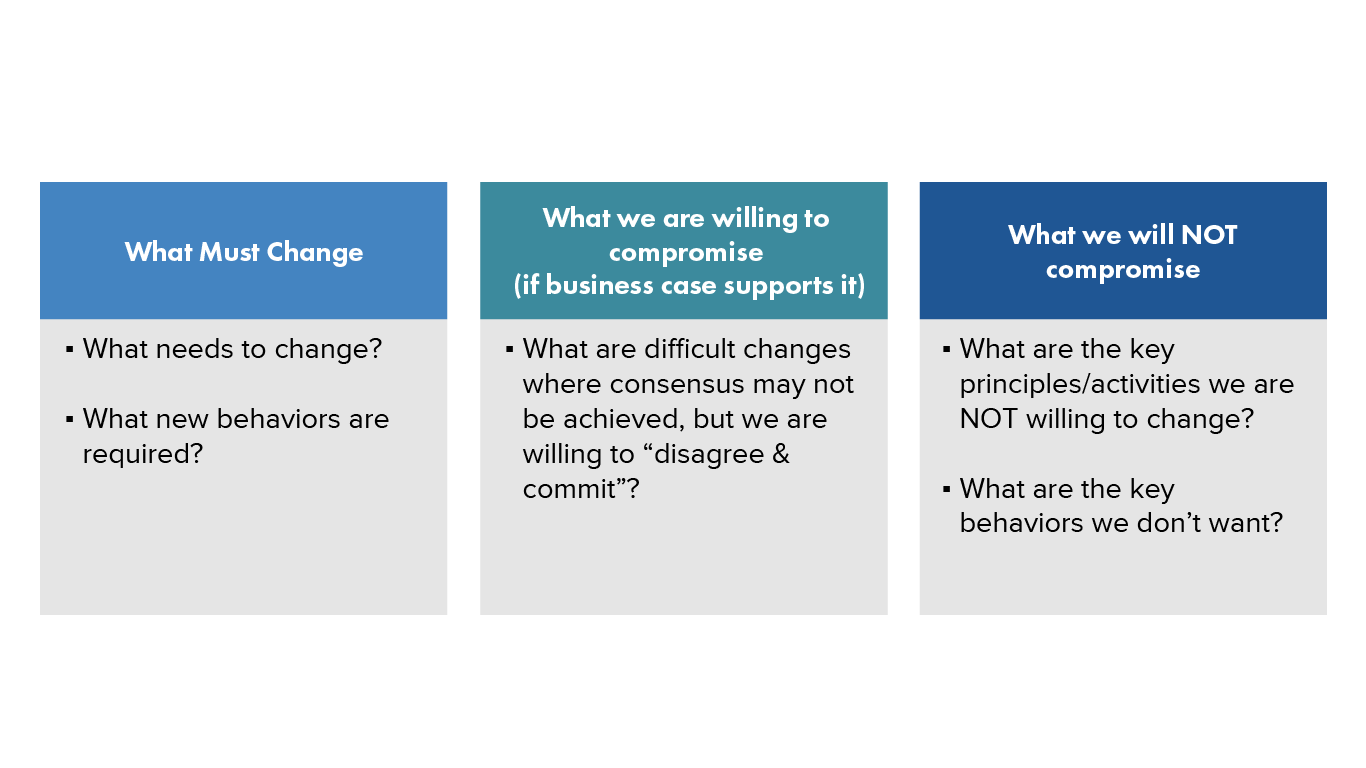Guiding Principles for Decision-Making with Enterprise Destination Mapping
Our Enterprise Destination Mapping (EDM) methodology is a framework that articulates an organization’s ambition using strategic imperatives, supporting pillars, and specific steps to drive a transformation. One of the most important foundational steps in our Enterprise Destination Mapping methodology is to align on the guiding principles that are referred to prior to making any further business decisions. As part of our four-part series on EDM, we will cover the importance of guiding principles for decision-making and how to define them in support of the vision. Simply put, guiding principles are what an organization can and cannot do to ensure its long-term viability. They serve as the guardrails when determining how to achieve the vision.

Importance of Guiding Principles
Well-developed guiding principles provide clarity and visibility into a company’s chosen position in a market, grounded in a view that aligns to the overall vision and strategic imperatives, like what markets to enter or exit. For example, if a company has defined a clear distinction around the types of products or service offerings it provides, it can make informed decisions about whether to enter new markets or expand its offerings. This can help the company avoid the risk of entering markets that are outside of its core business, which can be costly and ultimately lead to failed initiatives. Articulation of guiding principles can create alignment among leaders and teams for day-to-day decision-making when there is well-defined strategic intent. This enables the organization to move in lockstep.
Guiding principles can, consequently, be employed in and of themselves as an approach to strategic alignment (dos and don’ts) or as a differentiated lens on specific strategic decisions. Having clearly defined guiding principles allows a company to focus on its strengths and core competencies. By defining what leaders will and won’t do, an organization can concentrate its resources and efforts (time, people, revenue) on its core business, which increases efficiency and effectiveness. This, in turn, is essential for long-term success.
Well-considered guiding principles help organizations to avoid strategic drift. Strategic drift occurs when a company loses its focus and drifts away from its core business, or when an organization gets lost in indecision, which can lead to a decline in performance and ultimately, missed business objectives. Guiding principles that are well-known and established can be referenced when making strategic and tactical planning/decisions to avoid strategic drift. By basing its strategy on guiding principles, an organization can stay true to its core business (its true north) and avoid the risk of losing focus.
By putting guiding principles into practice, leaders can mitigate risk more effectively, as they will make decisions that are well-aligned with the overall vision rather than succumbing to “shiny object syndrome” for opportunities that don’t directly contribute or align with the core business. When presented with a new opportunity, it’s imperative to question how it aligns with an organization’s short- and long-term plans. This can help maintain stability and avoid potential losses.
Strategic Questions to Frame Outcomes from Guiding Principles Discussions
All strategic projects, either explicitly or implicitly, involve choice(s) and tradeoffs to consider. When framing discussions around guiding principles, it’s important to dig deep into the following categories of questions to ensure alignment on the guardrails that will frame decision-making. Examples of major decisions that executives make that would benefit from guiding principles discussions include:
- Should our organization focus on differentiation or maintenance of low-cost operations?
- Will business be solely driven by organic growth, or would M&A be on the table?
- Would our business shift focus away from being customer-first to preserve the bottom line?
- Is our organization willing to streamline spans and layers to grow profits, or would headcount adjustment be a last-resort alternative?
As an outcome from this process, there should be detailed documentation that clearly and definitively articulates the critical guiding principles.

Leveraging Enterprise Destination Mapping to Define Guiding Principles
Concrete guiding principles are critical for leadership alignment when put to the test of making business decisions through to execution. By defining what the organization will do and be versus what it won’t do or become, it can create alignment throughout the organization by focusing on its core business, avoiding strategic drift, making informed decisions about markets to enter or exit, and managing risk more effectively.
Ultimately, having clear boundaries can help an organization stay true to its core business and increase the likelihood of long-term success. In our next post, we will be discussing how to set goals that encompass the vision and guiding principles defined thus far in the business transformation strategy.
If you’d like to learn more from our organizational transformation team, contact us here.
Subscribe to Clarkston's Insights



